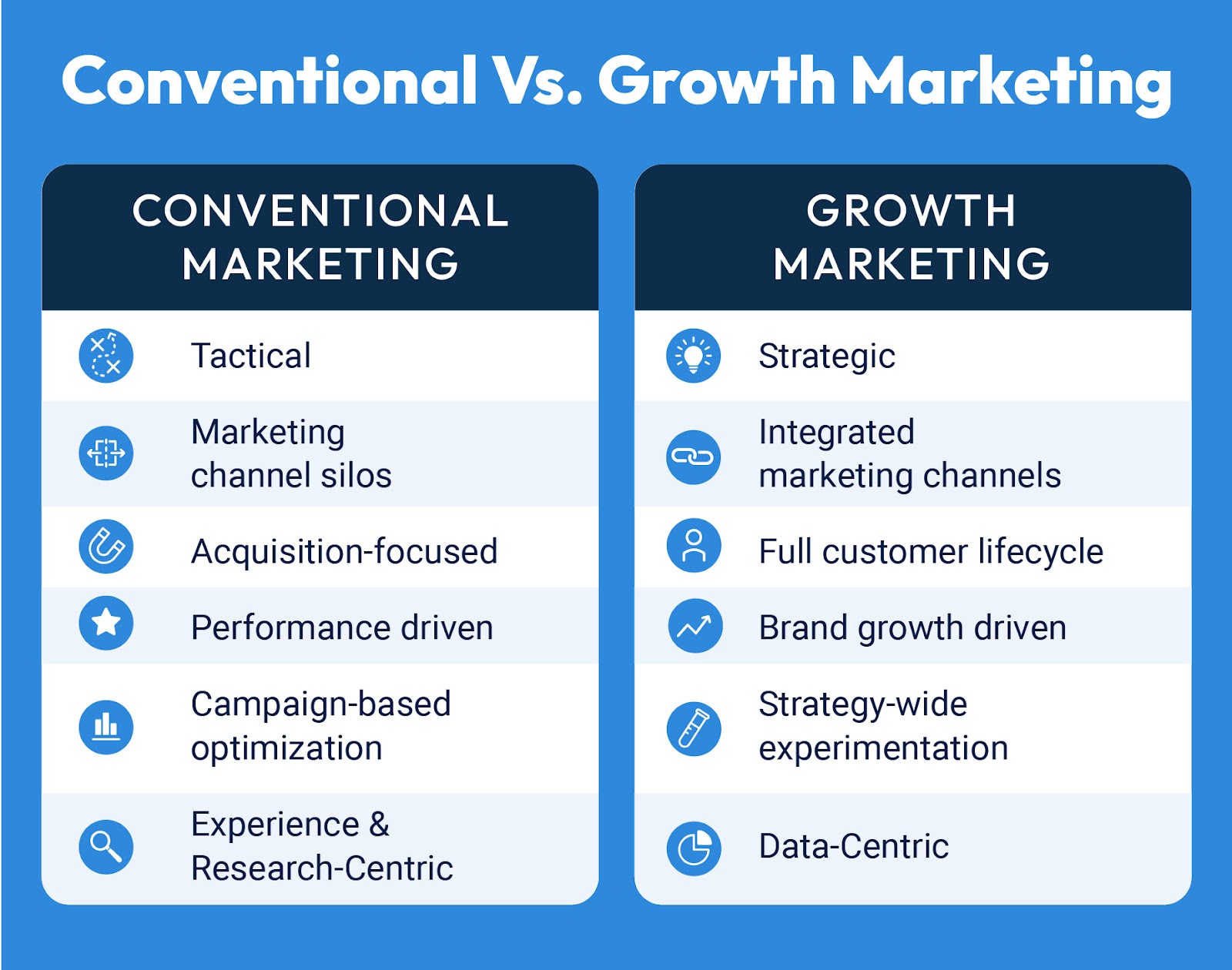Getting big results requires ambitious new ideas and the right people to put those ideas into action. One of these new ideas, termed Growth Marketing, is one of the most revolutionary new ideas to make its way into the business world in recent years.
Growth marketing is not your everyday marketing strategy. Whereas conventional marketing focuses on acquisition, this multifaceted method considers the entire customer journey from awareness to retention in an integrated approach to the marketing process.
As we explore the foundational ideas behind growth marketing, you’ll learn how this innovative approach could become your roadmap to sustainable business success.
What is growth marketing and how is it different?
To define growth marketing, it helps to first talk about what it isn’t.
Most marketing strategies focus on customer acquisition through segmented tactics. For example, a digital marketing strategy might deploy a Facebook specialist to manage social media ads, an email marketing specialist to A/B test list segments, and a content marketing specialist to increase organic traffic through SEO. Each team member is laser-focused on analyzing their own data and optimizing marketing campaigns to acquire new customers within their respective channel. Some businesses also employ offline traditional marketing strategies like TV, radio, billboards, and direct mail to increase brand awareness.
A growth marketing strategy may utilize any or all of these tactics. However, rather than compartmentalizing, it connects the data from every channel to create a big-picture strategy that integrates all marketing components into a unified funnel that touches every stage of the customer journey.

When brand awareness, lead generation, sales, customer satisfaction, and product development work hand-in-hand, marketing strategy can respond to real-time data with agility, driving company growth more rapidly and sustainably than conventional marketing methods allow.
Advantages of a Growth Marketing Approach
- Process efficiency
- Scalability and agility
- Speed to ROI
- Long term, sustainable growth
- Deeper brand loyalty
- Higher retention
Understanding the Complete Customer Lifecycle
Most business owners and marketers are aware of how a sales funnel can help reach prospective customers on their purchasing journey. While a traditional sales funnel encompasses the three primary stages of awareness, interest, and decision, growth marketing follows a more robust customer journey framework, often referred to as “AARRR.”
Acquisition/Awareness – Growth marketing looks at ways to acquire new customers through increased brand awareness and targeted lead generation. A variety of channels at the top of the funnel are tested, such as video marketing, Search Engine Optimization (SEO), social media, PR, and email marketing, to see which ones drive the most traffic, have the lowest cost per acquisition, and best conversion rates.Kickstart your growth marketing strategy with these lead generation ideas.
Activation – Once leads are acquired, activation tactics nurture them from an interested party to a new customer. For some companies, an activation event may simply be creating a free account or downloading a piece of content. For others, it would be signing up for a call or redeeming a coupon. Growth marketers measure the time it takes from acquisition to activation and find ways to shorten the span where possible. They also measure what spurred customers to become activated. Check out these conversion strategies to boost customer activation.
Retention – To keep churn low, companies measure customer retention to see which products, features, and services customers use the most. They rely heavily on data analytics platforms to garner insights on what can be done to maximize the customer experience and keep them engaged longer. This is seen by many as the ultimate metric. If a product or service delivers a bad user experience, then the company will have poor retention. Encourage long-term customer loyalty with these retention marketing strategies.
Referral – How can you turn your customers into advocates? To understand this, growth marketers measure the number of referrals given by existing customers and institute referral programs to grow a strong customer base from their most loyal users. If the product or service is strong, then referrals should naturally follow. Check out these referral marketing strategies to help build your customer base and improve client satisfaction.
Revenue – Business owners know it takes more than a sale to generate profits. The ultimate goal of growth marketing is to create sustainable growth by scaling revenue from both new and existing customers. This is accomplished by decreasing new customer acquisition costs through the refinement of the funnel and growth of brand loyalty over time.
Core Pillars of a Growth Marketing Strategy
There are five core pillars that drive the data-based decisions in a growth marketing strategy:
Multi-Channel Marketing
In order to reach the target audience across the entire spectrum of the customer journey, growth marketing uses an agnostic or omni-channel approach to identify which ones most effectively drive growth for the company. Rather than focus on just one or two tactics, a more aggressive approach is taken to testing all viable channels, both online and offline.
Growth Marketing Channels
Email Automation
Social Media
SEO
Content marketing
Webinars
PR
Digital Advertising
Affiliate marketing
Reputation Management
Trade Shows
TV & Video ads
Direct outreach
Data-Driven Strategy Decisions
Growth marketing uses quantifiable metrics and data to inform all aspects of a marketing strategy. Rather than basing decisions on gut feelings or assumptions, data-driven growth marketers rely on hard numbers to guide their actions and evaluate the success of a campaign.
Data is collected and analyzed from many different sources across the marketing channels—website analytics, lead generation response rates, social media analytics, email marketing analytics, customer surveys, and more. This data can provide insights into customer behavior, preferences, and trends, which is then used to identify the most effective channels and strategies and refine marketing tactics.
A/B Testing
Growth marketers rely heavily on testing their marketing efforts to achieve the most optimized sales funnel possible. They remain agnostic to preferences or trends, instead using all of the valuable data collected to guide marketing strategy. They test and tweak the messaging, email timing, landing page design, pricing, incentives, and timing until they are confident they have the best version possible.
Automation
With so many moving pieces and different marketing channels in play, growth marketing teams rely on and invest in automation software to successfully run their growth marketing campaigns. Running a multitude of tests at all times and keeping data sets organized requires a set of powerful tools. Companies typically use an all-in-one marketing software to ensure their operations are streamlined and they always have real-time visibility into progress.
Measurable Goals
Relentless testing and commitment to refinement ultimately lead companies to see significant success from growth marketing. While the standard for perfection never stands still—markets change, new competitors arise, and customer needs evolve—a focus on specific, measurable goals keeps businesses moving forward and generates sustainable long-term growth.
Growth Marketing vs Growth Hacking
While growth marketing and growth hacking are different methodologies with distinct goals, growth hacking is a tactic used by many successful growth marketers. Its goal is to achieve rapid growth in a short amount of time using creative experimentation, viral marketing, testing, aand optimization. Growth hacks have immediate, short-term goals that typically rely on non-traditional media sources like social media and influencer marketing to reach a wide audience of potential customers at a fraction of the conventional cost.
How Growth Marketing Success is Measured
Digital data is integral to a growth marketing strategy’s implementation across the full customer lifecycle, so it’s natural that there are key performance indicators (KPIs) to measure across each stage. The four most critical KPIs for monitoring are:
Churn Rate: This is the percentage of customers who stop buying from your business over a specific period of time. You want this number to be as low as possible, meaning that more of your customers stick around. If it’s not, you have either a product issue or a marketing issue due to attracting customers that aren’t a good fit.
Retention Rate: Similar to churn rate, this is the percentage of customers who keep using your product or service over a certain time. If the product is working and the marketing is reaching qualified users, this number should remain low.
Customer Acquisition Cost (CAC): This is the amount of money you spend to get a new customer. In growth marketing, the data should inform which channels and messages are getting the most conversions to help lower the cost of customer acquisition.
Lifetime Value (LTV): This is an approximate amount of money your business will make from a customer over time. It helps you understand how much you can spend to get a new customer and still make a profit.
Is growth marketing right for your business?
If you have a business that…
…has a strong market base but struggles to unify the layers of its marketing funnel,
…places a heavy emphasis on connecting with its customers and understanding their needs, but is unsure of how to leverage that feedback and relationships,
…has ridden the roller coaster of feast-or-famine success and is ready for sustainable big growth,
…is flexible, adaptable, and digitally savvy,
…then growth marketing may be a fit for your business — take the next step with our hands-on guide to strategies you can use today to start transitioning your company to a growth marketing approach!
8 Foundational Strategies For Establishing Your Growth Marketing Machine
About Kartra
This blog is brought to you by Kartra, the all-in-one online business platform that gives you every essential marketing and sales tool you need to grow your business profitably – from sales pages and product carts to membership sites, help desks, affiliate management and more. To learn how you can quickly and easily leverage Kartra to boost your bottom-line, please visit kartra.com.


